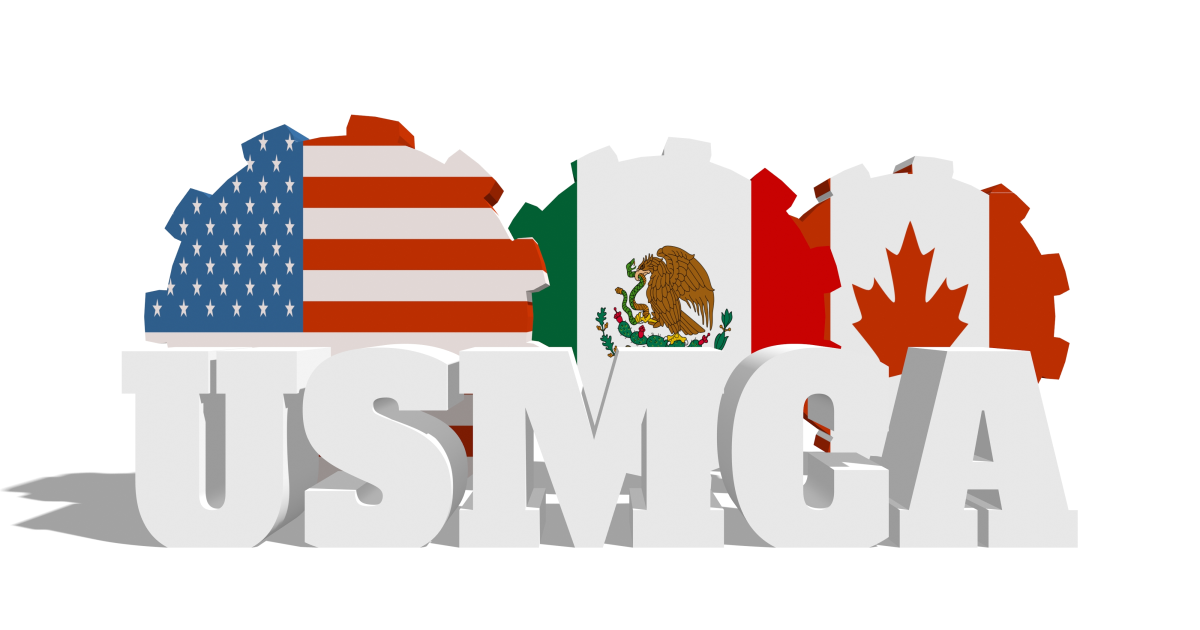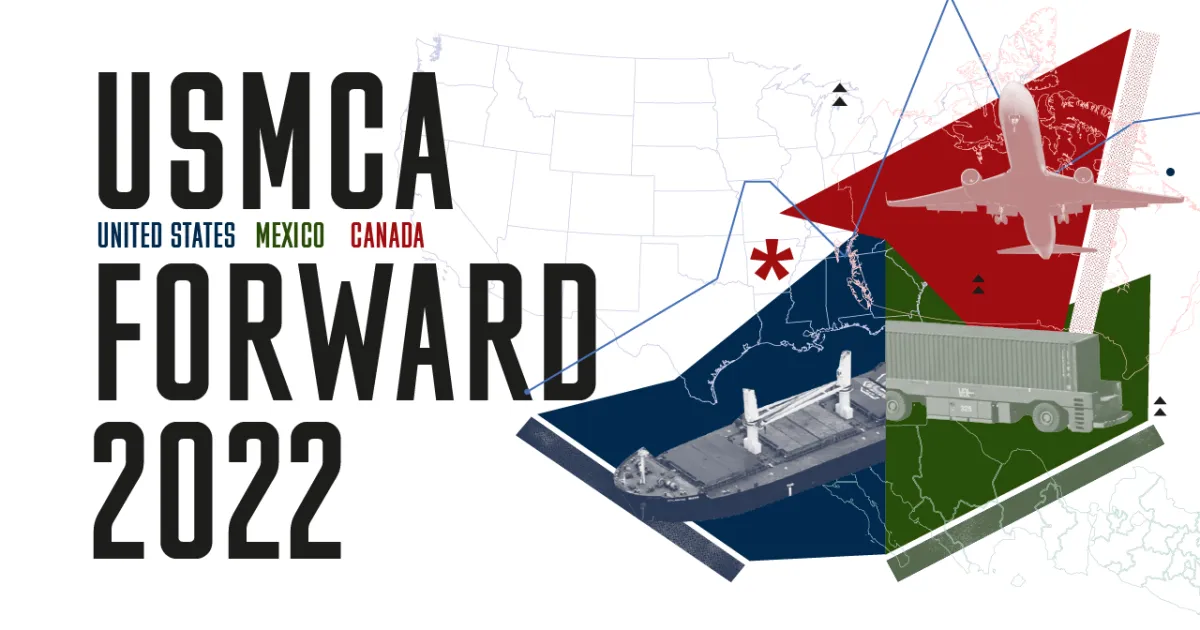
CHAPTER 3
HUMAN CAPITAL
Preparing Mexican youth to harness job opportunities in North American higher technology supply chains
Three decades ago, access to education in Mexico was defined as a basic human right and consequently as an obligation of the State. This constitutional principle has guided public policy, investment, diversification of services, and more importantly, the quest for quality, relevance, and connection to social needs and economic growth.
Despite an impressive expansion in coverage and access to all levels of education, the system needs to focus on quality and inclusion to improve the opportunities that young people may have in the more dynamic labor markets that will develop in the North American Region.
The main challenges are related to the inclusion of children and adolescents that have traditionally left school before they complete compulsory education; the second area of improvement has to do with pedagogy and teaching and learning practices; the third involves a radical change in the preparation of adolescents and young adults for work and lifelong learning.
Specifically, in youth’s case, their skills and abilities will need to be better aligned to the requirements of the more demanding formal employment markets expected to develop soon.
As we advance in the context of USMCA towards the integration of supply chains in high tech manufacturing and other sectors of our economies, more human talent will be needed, and more of our young people will have unprecedented opportunities to be creative and progress through a trajectory of professional and personal achievement.
If Mexico is to improve its productivity and eventually become an alternative manufacturing destination to China (Meltzer, 2021), it needs to strengthen the national education system with more decentralized and flexible educational policies, with school-based improvement of learning, with more and better investments in educational technology and infrastructure and with a continuous dialogue with all national and regional stakeholders.
Despite an impressive expansion in coverage and access to all levels of education, the system needs to focus on quality and inclusion to improve the opportunities that young people may have in the more dynamic labor markets that will develop in the North American Region.
The increase of competitiveness in Mexico depends largely on the development of its human capital nationwide, a process that would benefit from a wide array of cooperative regional projects involving student mobility, research, and short-term practical courses for young students engaged in dual and apprenticeship programs in which corporations and small businesses play a key role.
During the NAFTA years, international cooperation flourished mainly in universities and research centers. Although the dynamic has suffered from changing circumstances in policy, funding, and the negative impacts of the COVID-19 pandemic, there is a valuable accumulation of successful experiences and best practices to build on. The two new emphases in the construction of a new generation of trilateral agreements entail a specific focus on work related learning and the inclusion of high school level students currently pursuing vocational and technical training.
The size and organization of the Mexican education system
In 2020-2021, the Mexican Education System served over 37 million students or 29 percent of the total population. About two-thirds received basic education (preschool, primary, and lower high school), 14 percent were in upper high school, 13.4 percent in higher education and about 5 percent were enrolled in vocational and training non-degree programs. (MEJOREDU, 2022; SEP, 2022)
School attendance in primary and lower high school is practically universal, in contrast, only two thirds of adolescents, 15 to 17, were enrolled in upper high schools. Over the next decade, the number of children in primary, secondary, and upper high school will continue to decrease, while the demand for higher education—if graduation rates from upper high school improve—is expected to continue growing at a fast pace. These demographic changes are a chance to achieve universal coverage in upper high school and transition to tertiary studies for most young adults.
In all levels of education, services are predominantly public with 89.3 percent of preschool to upper high school students enrolled in a public school. In higher education 29 percent attended a private establishment.
In Mexico, the organization of the upper high school level is highly complex as there are general (or preparatory) and technological schools under the control of the federal government (22.7 percent of enrollment); state governments are responsible for about half of the students and the rest attend a private or an autonomous school. From the organizational standpoint, problems are the dispersion of the programs of study, lack of coordination among levels of governance, and the lack of common standards.
When considering human capital development policies, it is critical to focus on the 15 to 17 age group for the following reasons: First, there is the question of the large proportion of out of school adolescents in this age group who need access to knowledge and skills in order to participate in the work force; second, those who are enrolled in upper high school need to graduate in a larger proportion and with the knowledge, skills, and abilities needed to make successful transitions to tertiary studies and/or formal employment; and last, because these still numerous young generations will be strategic to the goals of increasing productivity, sustained economic growth, and a better distribution of wealth.
The opportunities to access formal employment in supply chains: A reference to semiconductors
The last census (INEGI, 2020) reports 31 million Mexicans between the ages 15 and 29, representing a fourth of an otherwise aging population. Although the demographic bonus is not as large as it was at the beginning of the 21st century, there is still a good opportunity to take advantage of the potential of a large pool of young people adequately trained, motivated, and guided to opportunities in labor markets and life-long learning.
In the context of the United States- Mexico-Canada Agreement (USMCA) trade agreement and in the aftermath of the COVID 19 pandemic, the design of new policy approaches to strengthen education, skills, and competences for all the young residents in the three countries, assumes a remarkably high priority.
As widely accepted, access to talent is fundamental to innovation and the construction of ecosystems favorable to the development of initiatives that may scale and multiply in selected manufacturing and service sectors throughout our territories (Meltzer, 2021). If we focus on the 15- to 19-year-old Mexican population, a subset of 10.8 million, we observe that only about half of them are currently enrolled in high school and that about 70 percent will finish. In contrast, recent indicators show universal coverage for this age group in the U.S. and Canada and completion rates of 83.2 percent in the U.S., 86 percent in Canada, and up to 99 percent in Korea. The goal of including all the Mexican youth in the opportunities afforded by the integration of supply chains will be possible if gaps in access and graduation rates are closed and quality and relevance of education and training are substantially enhanced. (OECD, 2018; 2019)
In 2021-2022, the Mexican Ministry of Education reported over 5 million men and women enrolled in higher education, 89.2 percent undergraduates with over a third attending private establishments. Coverage in higher education has been growing dynamically over the past two decades (ANUIES, 2022).
In the case of recent bilateral and trilateral discussions on the high-profile sector of semiconductors, the consensus is that coordination between policymakers in the areas of economic development and education is essential.
Approximately 650,000 young adults graduate from tertiary studies every year; out of this total, some 140,000 are engineers. In principle, there is an attractive pool of professionals in the diverse areas of the field with about 100,000 individuals specialized in electronics and automatization, ICT, and the largest proportion, in mechatronics, that is, in areas with potential growing demand in high-tech manufacturing sectors like semiconductors (Filippo; Guaipatín, Navarro and Wyss, 2022).
As recent studies show, there is presently an apparent excess of engineers, however, when data is disaggregated by region, there is a deficit of qualified professionals in the west and northeastern states where the most dynamic enterprises linked to the semiconductor chain of value are located. This fact speaks to the weak coordination within the higher education system and between all actors engaged in innovation (Filippo; Guaipatín, Navarro and Wyss, 2022).
Although recent indicators point to a relatively satisfactory supply of trained professionals in engineering and technology at the national level (ANUIES:2022), there is a bottleneck in the transition from lower to upper secondary schools, and an even more visible difficulty for young adults to complete high school.
There are challenges to educating and training young people, not only in access to high school and completion rates. Learning results and employability also underperform. At the same time, it is important to acknowledge progress as the 15-24 population features higher educational attainment compared to the 40-49 age group. The gains are larger for women, who by 2022 represented 55 percent of new professionals.
Education is an essential part of participating and progressing in the formal labor markets. As in other countries, Mexican youth has faced severe restrictions to secure employment and reasonable wages, a situation that worsened during the pandemic. In 2022, there were 9 million young men and women 15 to 24 who worked or were seeking employment. About half of them worked full time and two fifths earned the minimum wage (IMCO, 2022).
The unemployment rate of the young (6.4 percent), is almost twice the general rate of 3.5 percent, additionally, 67.4 percent were engaged in the informal sector, a fact that, as has been shown, may have a negative effect over their occupational trajectories because there is a higher probability for them to remain in the informal sector (IMCO, 2022).
Young adults with a college or a high school diploma do better in terms of securing formal employment and better wages, but even if their school attainment is higher than the one featured by previous generations of workers, the probability of first entering the informal sector and remaining there for a prolonged period, is still high (Blanco, Solís y Robles, 2014; CEPAL/OIT, 2017; INEGI, 2019; Lund, Madgavkar, Manyika, Smit, Ellingrud and Robinson, 2021).
In sum, education and training for adolescents and young adults does not connect to the opportunities of emerging labor markets, particularly in the higher technology sectors linked to North American supply chains. In the case of recent bilateral and trilateral discussions on the high-profile sector of semiconductors, the consensus is that coordination between policymakers in the areas of economic development and education is essential to the successful launching of a strategic and comprehensive plan to develop new talent and retrain workers with a focus on the priorities of subnational development programs.
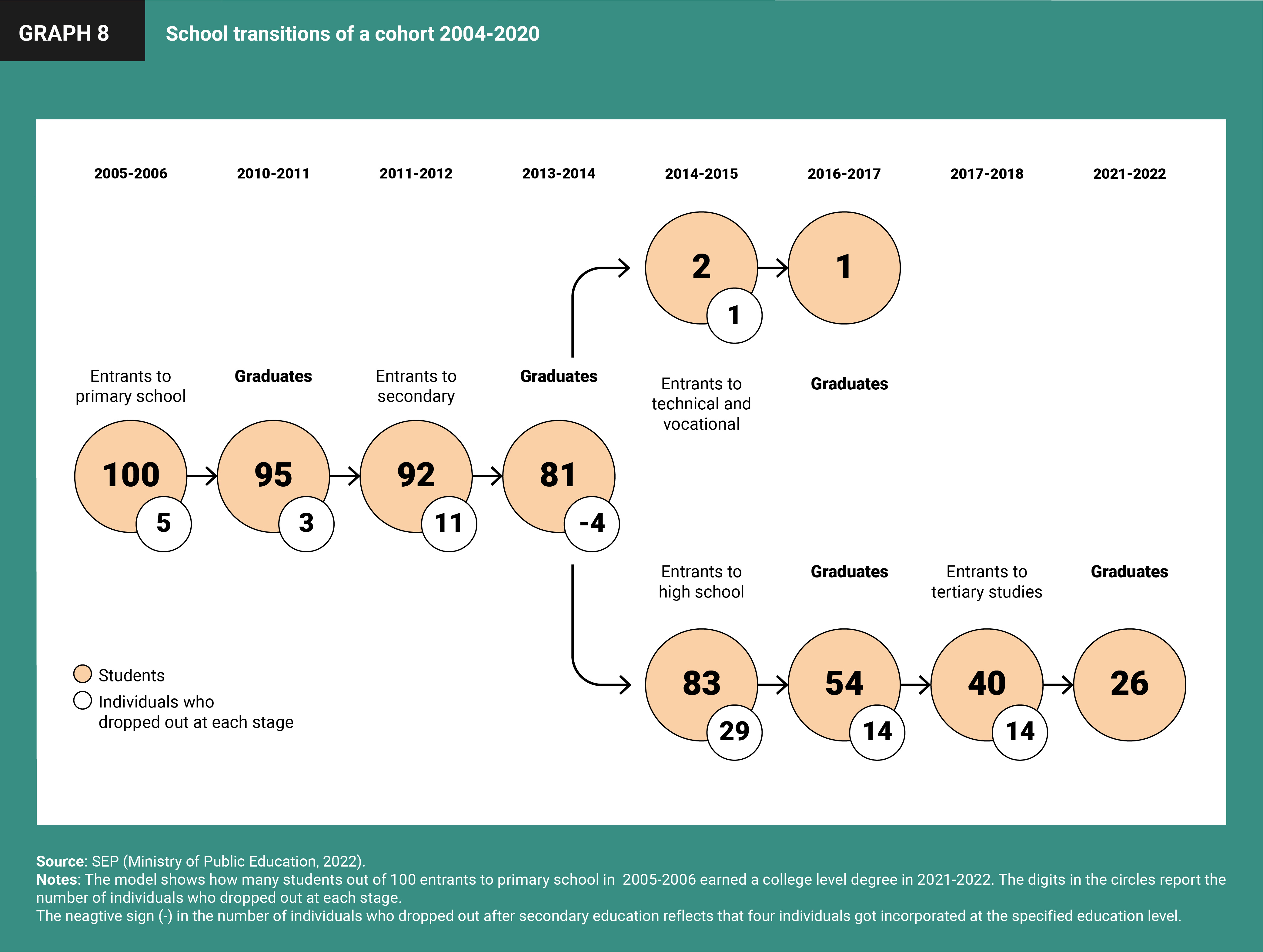
Public policy in education: The thrust towards inclusion, quality, and successful trajectories
The performance of the national education system, one of the largest in the world, needs to improve substantially in terms of inclusion, quality, relevance, and adaptation to global changes and societal needs. Not only do children leave school before completing junior high school, but a considerable proportion of those who enroll in upper high school will not graduate.
This means that close to a million young adolescents will be working in the informal sector with a high probability of not returning to education (MEJOREDU, 2022; OECD, 2022; SEP,2022).
Learning outcomes of children and adolescents have been measured with internal and international standardized examinations from year 2000 and onwards. Accordingly, national (PLANEA and EXCALE) and international evaluations (PISA) were conducted on a yearly basis. Results of national testing for the period 2014-2018 show that six out every 10 students in Mexico scored below proficiency in math, and about half of them in reading (INEE:2017).
More importantly, evidence shows that whether we consider national or international evaluations, test scores in core areas such as math, language, and science, have remained stable for over a decade.
As an example, in 2018 most 15-year adolescents of the 79 participating economies in the PISA exam scored between 482 and 545 points while Mexican students scored between 358 and 409. The highest averages were achieved by China (600), Singapore (570), Macao (560), and Hong Kong (550) (OECD, 2018).
Before the prolonged school closure period due to COVID-19, the Mexican education system was already in need of a total revamp. In the aftermath of COVID-19, overcoming the devastating learning effects on children and adolescents will likely require more decentralized policies geared at recovering learning, but this will not be enough.
Transforming education means redesigning schools and how they teach, it also involves inclusion, equity, celebration of diversity, and commitment of teachers and educational communities to protect the environment and develop a culture of peace (MEJOREDU, 2020; Darling Hammond, 2020.; Acevedo, Flores, Székely y Zoido, 2022).
There is an opportunity in technological upper high schoolswhere students and teachers showed during the pandemic—outstanding adaptation to distance learning, success in retaining students, and resilience and a will to contribute to the solution of their school community´s problems (SEMS-GIZ, 2022; CONALEP, 2021). One important finding of surveys conducted during the school closure period is that students greatly appreciated the focus of the curriculum in practical problems and the development of abilities and skills for work (CONALEP, 2021, Filippo; Guaipatín, Navarro and Wyss, 2022).
As many educators and policymakers have concluded, not only in Mexico but in other countries and regions, we have an opportunity to make radical changes in education (Darling-Hammond, 2020 and 2022 Acevedo, Flores, Székely y Zoido, 2022; UNESCO-SM, 2022). There is a chance to reinvent education and restart schools, particularly the ones that serve the young.
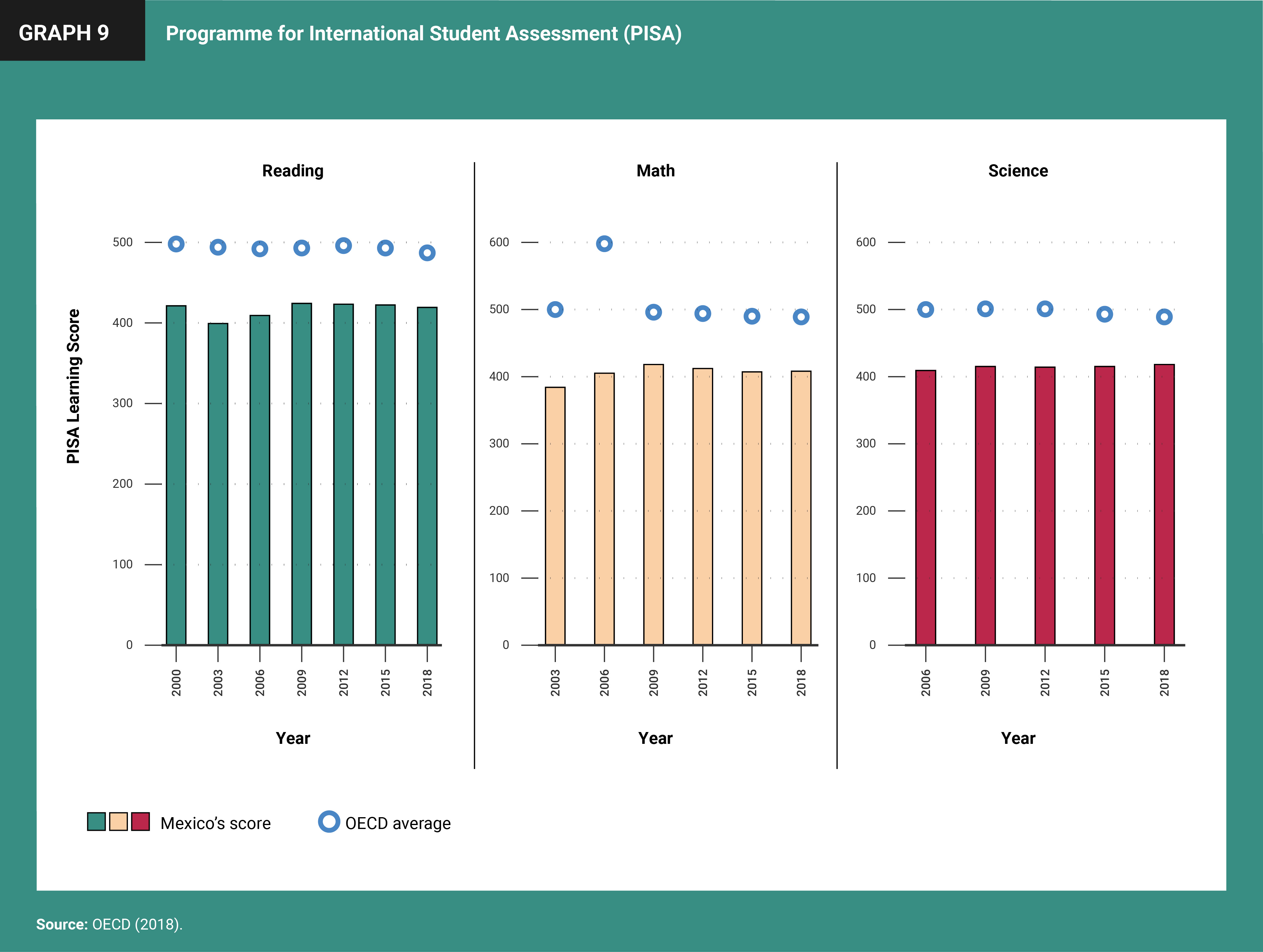
Dual education as a strategy to connect youth to work at an early age
As already noted, mitigating the dropout rates is contingent upon changes in the curriculum, the development of strong teaching methods and practices, access to technological resources, more investment, and the construction of supportive, safe, and motivating school environments. Studies and survey data show that for most, the main reason to leave school is poverty, however, a considerable proportion of dropouts report that they were bored or considered class attendance senseless (Solís, Leal and Brunet, 2014 and 2015).
The feeling of futility is stronger among students enrolled in technological high schools, who expected a more hands-on approach to learning and a closer connection to work. One of the policies launched (in 2013) to respond to students´ interest in practical training and a better alignment with opportunities in formal labor markets, was the “Mexican dual education model” developed by the Ministry of Education in collaboration with the most important national business organizations (SEMS, 2018)
The first projects in areas like electricity, mechanics, ICT, administration, and tourism were implemented in 11 States, with the participation of 59 schools, 197 large companies, mostly in the automobile sector, and 915 students (SEMS, 2018).
Progress will depend on a better understanding of the way technical and vocational systems work in each country and on our determination to adapt so that ambitious and sustainable collaborative training and development programs are viable.
Follow up and qualitative evaluation studies (UNICEF, 2018) showed that the rules and processes of the program were rigid and demanded excessive time and energy from schools and companies. Ultimately, requirements for graduation and certification of competences were complicated and long.
These factors were major impediments to scalability and multiplication of initiatives. Nevertheless, the outstanding results in terms of the quality of the learning experience of students and teachers—in combination with a renewed interest in the development of young talent on the part of industries engaged in high-tech manufacturing—make dual and apprenticeship models an attractive collaborative endeavor, where all the players may coordinate and construct local and regional ecological systems to foster innovation.
Dual and apprenticeship models in technological schools, colleges, and vocational training centers are an effective response to the learning crisis of adolescents and young adults (López, Opertti and Vargas, 2017; Smeck, Oviedo and Fiszbein, 2020) and a tool to address their employability and early engagement in the world of work, business, and entrepreneurship.
A recent survey (SEMS, 2018) among students, school principals, and company staff who took part in dual initiatives illustrates the enthusiastic perceptions of students both male and female. They valued especially a new sense of self-worth, their enhanced abilities in communication, teamwork, commitment, and discipline, and the feeling that they could succeed in their future careers.
Opinions in the case of schools and companies were less passionate but still positive. In the first case, school prestige is highly valued, while connection with the education sector and social recognition are seen as positive outcomes for companies (SEMS-GIZ, 2018).
However, companies tended to regard their participation as part of their social responsibility rather than as a device to find talent that could, once recruited, contribute to productivity gains and enhanced quality of processes and products.
External evaluations, surveys, and the analysis of norms, supported the launching of a fresh, more flexible version of dual education, a new concept that encourages local designs of content and practice with the participation of sectors, companies, academia, schools, and communities (UNICEF, 2018; SEP, 2022).
Case studies: Learning how to coordinate, complement, and work as North American teams
Recent dialogues among relevant actors involved in the manufacture of semiconductors in the North American region has facilitated a flow of information on the industry´s needs and expectations. Research and development centers brought to the table their strengths in science and engineering, while universities and technical high school-level subsystems presented their dual education success stories and expectations to take part in the configuration of regionally based ecosystems with the support of national and subnational governments (Secretaría de Economía, 2022).
From the standpoint of the kind of education and training that young entrants to the labor market need to progress in an attractive lifelong learning career, the consensus was that the best roadmap would start with a concrete experience—a case study—from which all parties could learn.
As an illustration, the case of an important firm in the semiconductor sector, Skyworks, may be cited. The company located in the state of Baja California, has a long-standing interest in human capital development, and has already built strong ties with local and regional universities, research centers, and high schools. Recently, in alliance with CONALEP,1 a dual program, including curriculum and schedules for practice in their Mexicali plant was jointly developed and will start operating next academic year with the support of the subnational government and all parties engaged. After a three-year cycle, external evaluation will show necessary adjustments. It is expected that the model may be adapted to the contexts of the States of Jalisco and Chihuahua where governments, research centers, and corporations have already engaged in building up an adequate environment for investment and collaborative development of resilient supply chains.
This is only an example to illustrate the potential economic and social impact of consortia and alliances that are already multiplying in other sectors and regions in Mexico. Careful follow-up will be instrumental in our search for effective educational, economic, and social policies that address the needs of all parties and especially those of our young cohorts.
Progress will depend on a better understanding of the way technical and vocational systems work in each country and on our determination to adapt so that ambitious and sustainable collaborative training and development programs are viable.
We should draw from the wealth of our technical and scientific cooperation experiences1 (ANUIES, 2022) to design more focused projects with the purpose of building a stronger, diversified, and well compensated workforce that may flourish and thrive in the North American region.
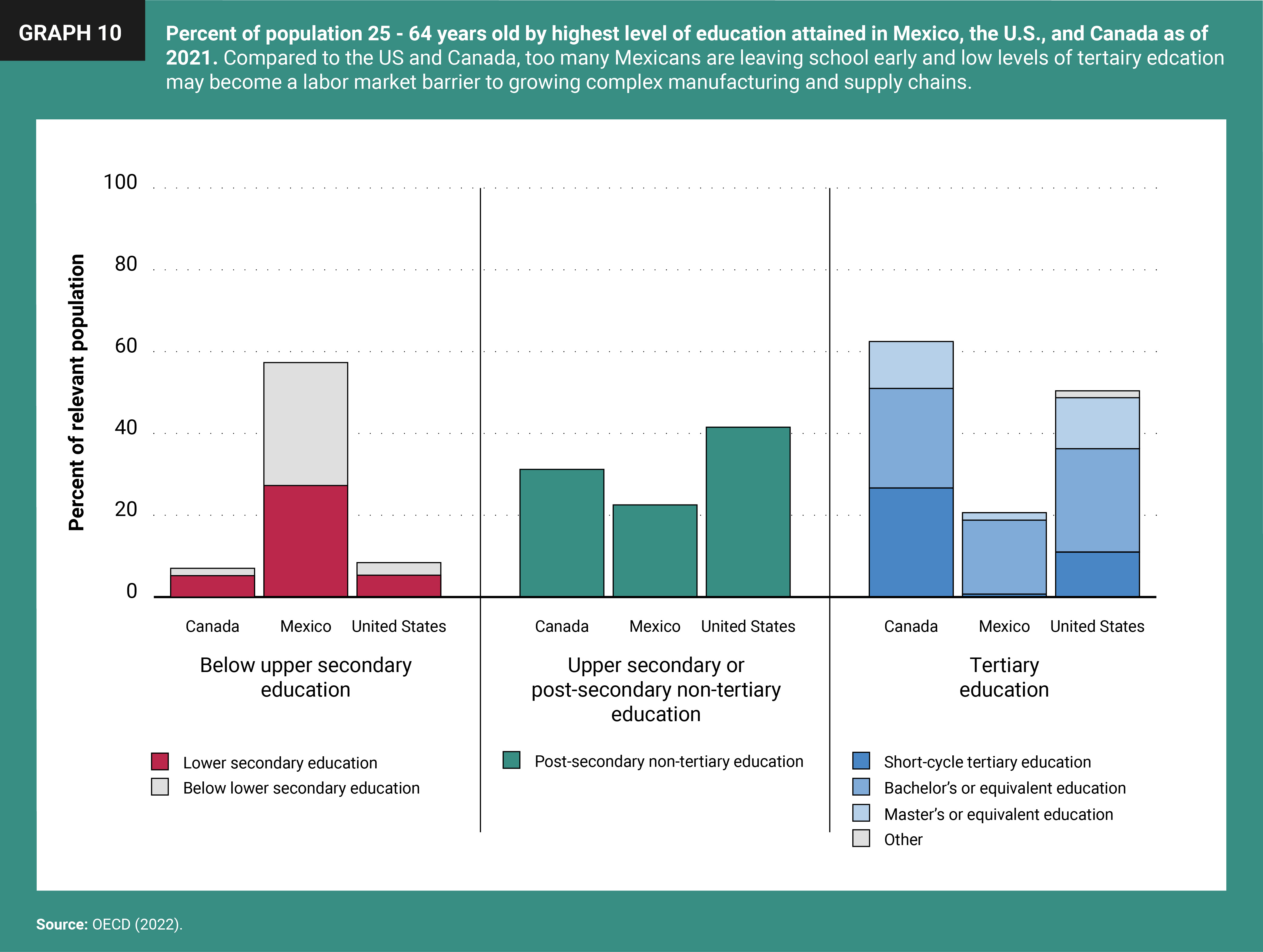
Endnotes
- 1. Successful cooperative agreements involved research consortia; double degree undergraduate and graduate programs; “sandwich graduate programs” and many other creative schemes. Participation of community colleges and professional training institutions has been comparatively low. A good point of departure to develop this new generation of agreements is comparing the landscape of the three systems in order to identify common interests, adequate partners and industries that are already involved. The expected agreements will most probably differ with respect to the more traditional academic partnerships.
References
Acevedo, I; Flores, I; Székely, M. y Zoido, P. (2022) ¿Qué ha sucedido con la educación en América Latina durante la pandemia? Washington: BID. Available in https://publications.iadb.org/es/que-ha-sucedido-con-la-educacion-en-america-latina-durante-la-pandemia
ANUIES (2022) Anuario Educación Superior-Técnico Superior, Licenciatura y Posgrado 2021-2022. México: ANUIES. Available in http://www.anuies.mx/informacion-y-servicios/informacion-estadistica-de-educacion-superior/anuario-estadistico-de-educacion-superior
Backhoff, E; et al (2017) Cambios y tendencias del aprendizaje en México 2000-2015, México: INEE. Available in https://www.inee.edu.mx/publicaciones/cambios-y-tendencias-del-aprendizaje-en-mexico-2000-2015/
Blanco, E; Solís, P y Robles, H editores (2014) Caminos desiguales, trayectorias educativas y laborales de los jóvenes en la Ciudad de México. México: Instituto Nacional para la Evaluación de la Educación-El Colegio de México. Available in https://libros.colmex.mx/wp-content/plugins/documentos/descargas/P1C230.pdf
CEPAL/OIT (2017) Coyuntura Laboral en América Latina y el Caribe. La transición de los jóvenes de la escuela al mercado laboral, Santiago: Naciones Unidas. Available in https://www.observatoriolaboral.gob.mx/static/estudios-publicaciones/coyuntura-laboral-latam.pdf
CONALEP (2021) 2do. Reporte ejecutivo de resultados Seguimiento de la situación de los estudiantes, docentes y directores del Sistema CONALEP ante la contingencia sanitaria COVID. México: CONALEP.
Darling-Hammond, L. (2000) “Teacher Quality and Student Achievement: A Review of State Policy Evidence” in Education Policy Analysis Archives. Available in https://www.researchgate.net/publication/240273279_Teacher_Quality_and_Student_Achievement_A_Review_of_State_Policy_Evidence
Darling-Hammond, L; Schachner A. and Edgerton, A. (2020) Restarting and Reinventing School Learning in the Time of COVID and Beyond. Palo Alto, CA: Learning Policy Institute. Available in http://learningpolicyinstitute.org/product/restarting-reinventing-school-covid.
Darling-Hammond, L. (2022) “The Road to Recovery in Learning: How California Points the Way”. Palo Alto, CA: Learning Policy Institute. Available in https://learningpolicyinstitute.org/blog/covid-road-recovery-learning-how-california-points-way
Filippo, A; Guaipatín, C; Navarro, L and Wyss, F. (2022) México y la cadena de valor de los semiconductores: Oportunidades de cara al nuevo escenario global, Washington: BID. Available in https://publications.iadb.org/es/mexico-y-la-cadena-de-valor-de-los-semiconductores-oportunidades-de-cara-al-nuevo-escenario-global
IMICO (2022) Índice de competitividad estatal 2022, México: Instituto Mexicana para la competitividad. Available in https://imco.org.mx/wp-content/uploads/2022/05/Reporte-Competitividad-Estatal-2022.pdf
INEE (2017) Plan Nacional para la Evaluación de los Aprendizajes (Planea). Resultados nacionales 2017. Educación Media Superior. Lenguaje y Comunicación – Matemáticas. México: INEE. Available in https://www.inee.edu.mx/publicaciones/plan-nacional-para-la-evaluacion-de-los-aprendizajes-planea-resultados-nacionales-2017-educacion-media-superior-lenguaje-y-comunicacion-matematicas/
INEGI (2019) Encuesta Nacional de Inserción Laboral de los Egresados de la Educación Media Superior (ENILEMS) 2019, México: INEGI. Available in https://www.inegi.org.mx/programas/enilems/2019/
INEGI (2020) Censo de Población y Vivienda 2020, México: INEGI. Available in https://www.inegi.org.mx/programas/ccpv/2020/
López, N; Opertti, R. and Vargas, C (2017) Adolescentes y jóvenes en realidades cambiantes. Notas para repensar la educación secundaria en América Latina, Francia: UNESCO. Available in https://unesdoc.unesco.org/ark:/48223/pf0000247578
Lund, S; Madgavkar, A; Manyika, J; Smit, S; Ellingrud, K and Robison, O. (2021) The future of work after COVID 19, Special Report McKinsey, USA: McKinsey & Company. Available in https://www.mckinsey.com/featured-insights/future-of-work/the-future-of-work-after-covid-19
MEJOREDU (2020) Sugerencias para el regreso a las actividades escolares en educación media superior, México: MEJOREDU. Available in https://www.gob.mx/cms/uploads/attachment/ file/563404/sugerencias-ems.pdf
MEJOREDU (2022) Indicadores nacionales de la mejora continua de la educación en México 2022. Cifras del ciclo escolar 2020-2021, México: MEJOREDU. Available in https://www.mejoredu.gob.mx/publicaciones/informe-de-resultados/indicadores-nacionales-de-la-mejora-continua-de-la-educacion-en-mexico-2022
Meltzer, J. (2021) Developing roadmap for USMCA success, USA: Global Economy and Development. Available in http://www.brookings.edu/wp-content/uploads/2021/09/Developing-roadmap-USMCA.pdf
OCDE (2018) Reading performance (PISA) in https://data.oecd.org/pisa/reading-performance-pisa.htm
OCDE (2019) México-Country Note-PISA 2018 Results. OCDE. Disponible en https://www.oecd.org/pisa/publications/PISA2018_CN_MEX_Spanish.pdf
Secretaría de Economía (2022) Foro Fortalecimiento de las Cadenas de Suministro de Semiconductores y TIC entre México y Estados Unidos. México: Secretaría de Economía, agosto. 2022. Available in https://www.youtube.com/watch?v=0wAzncqBb_k
SEMS (2018) La formación dual en la Educación Media Superior, México: SEMS.
SEMS-GIZ (2022) Resultados de la Encuesta de Monitoreo y Evaluación del Sistema de Educación Dual en México 2021-2022, México: SEMS. Available in https://educacionmediasuperior.sep.gob.mx/EducacionDualEncuesta22/
SEP (2022) ACUERDO número 02/02/22 por el que se emiten los Lineamientos Generales para la impartición del Tipo Medio Superior mediante la Opción de Educación Dual, México: Diario Oficial de la Federación. Available in https://dof.gob.mx/nota_detalle.php?codigo=5643226&fecha=18/02/2022#gsc.tab=0
SEP (2022) Principales cifras del Sistema Educativo Mexicano 2021- 2022. México: SEP-DGPPyE. Available in https://www.planeacion.sep.gob.mx/Doc/estadistica_e_indicadores/principales_cifras/principales_cifras_2021_2022_bolsillo.pdf
Smeck, S., Oviedo, M. y Fiszbein, A. (2020): Dual Education in Latin America. Challenges and Opportunities, Washington, D. C., Inter- American Dialogue. Available in https://www.thedialogue.org/wp-content/uploads/2019/12/Dual-education-12.9.2019-ENG.pdf
Solís, P. Leal, A and Brunet, N (2014) Informe final del estudio “Abandono escolar del primer semestre de la generación 2013-B del Colegio de Bachilleres”, México: COLBACH.
Solís, P. Leal, A and Brunet, N (2015) Informe final del estudio “Abandono escolar del segundo al tercer semestre de la generación 2013-B del Colegio de Bachilleres”, México: COLBACH.
UNESCO-SM (2022) Reimaginar juntos nuestros futuros. Un nuevo contrato social para la educación. Chile: UNESCO-Fundación SM. Available in https://unesdoc.unesco.org/ark:/48223/pf0000381560
UNICEF (2018) La agenda de la infancia y la adolescencia 2019-2024, México: UNICEF. Available in https://www.unicef.org/mexico/informes/la-agenda-de-la-infancia-y-la-adolescencia-2019-2024
Viewpoints
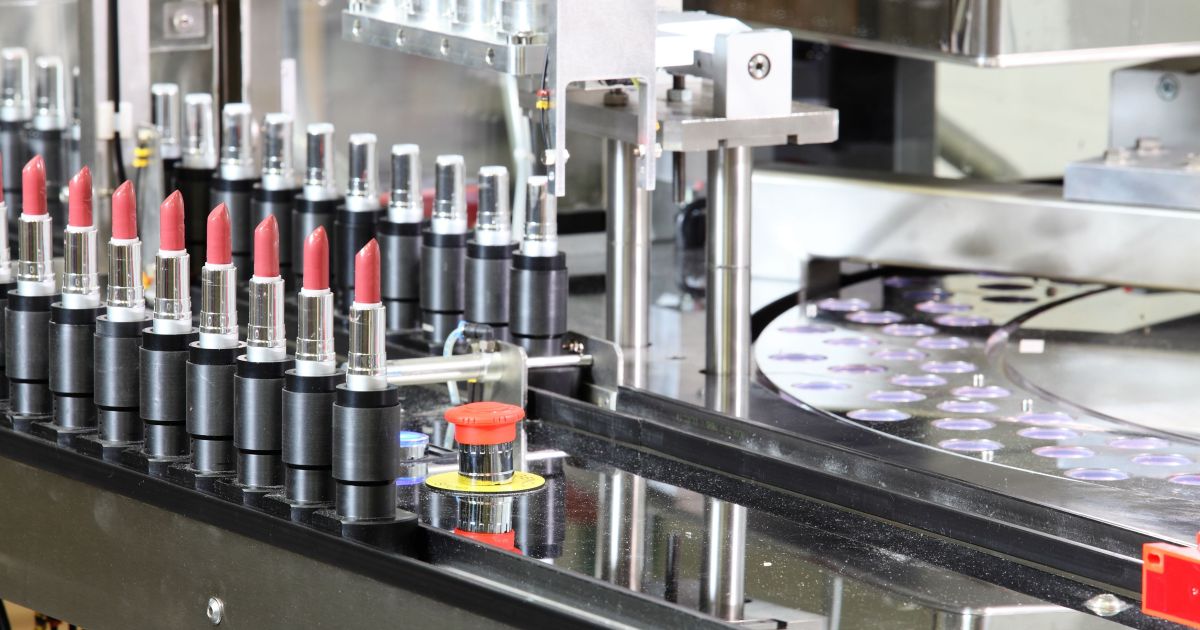
Jay Timmons explains how the governments of the United States, Mexico, and Canada must live up to and uphold the spirit of the USMCA to realize its rewards.
